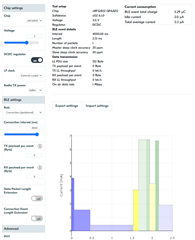Hello,
I'm working on a firmware for a device that is created using ble proximity example. It is power constrain device and required a connection interval of 30 sec between a master (Android phone only) and slave nRF52810.
I’m using the following version and device.
- SDK v17.0.2
- 2. s112_nrf52_7.2.0_softdevice
- Basically I’m using Android phones as my central or master device and nRF52810 as peripheral or slave.
Basic feature of the firmware
The architecture is based on Application Timer Event callbacks.
The firmware was prepared using the BLE Peripheral Proximity example.
In order to minimize power consumption the device runs a minimum of active GATT services listed below:
- TX Power
- Instant Alert Service (IAS)
- Instant Alert Service Client (IAS-C)
- Connection is BLE_PERIPHERAL
To get the desire interval I'm changing the following parameters. I have used different values for these parameters without violating the following two constrain but seem I'm not able to go beyond 15 sec interval ( 30 sec is desired). Is there anything I'm not doing correct.
//constrains
- conn_sup_timeout * 4 > (1 + slave_latency) * max_conn_interval
- (1 + Conn_Latency) * Conn_Interval_Max * 2 < conn_sup_timeout
// Parameters
- MIN_CONN_INTERVAL MSEC_TO_UNITS(800, UNIT_1_25_MS)
- MAX_CONN_INTERVAL MSEC_TO_UNITS(830, UNIT_1_25_MS)
- SLAVE_LATENCY 18
- CONN_SUP_TIMEOUT MSEC_TO_UNITS(32000, UNIT_10_MS)
I'm getting the following error whenever I try to increase slave latency.
- gap_params_init();
- APP_ERROR_CHECK(err_code);
- I think It might help you “void app_error_handler_bare(ret_code_t error_code)” here error_code = 0x00000007.
- APP_ERROR_CHECK(err_code);



